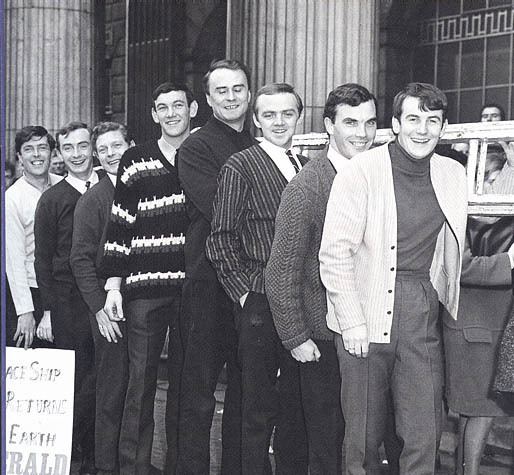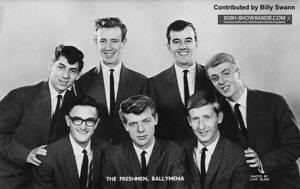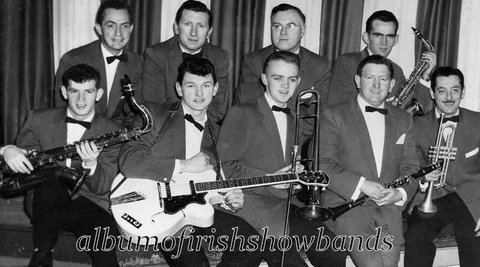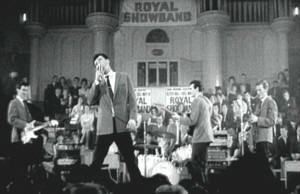 | ||
Similar | ||
A little bit showband brendan o brien
The Irish Showband is a dance band format which was popular in Ireland during the early rock and roll era from the mid 50s to the mid 80s. Some bands such as Eamon Keane's 'dream success band the Indians, who started as the Casino Showband in the early sixties are still on the go. The showband was based on the internationally popular six- or seven-piece dance band. The band's basic repertoire included standard dance numbers and covers of pop music hits. The versatile music ranged from rock and roll and Country and Western songs to traditional dixieland jazz and even a spot of Irish Céilí dance, a rigorous Newfie stomp, a rousing folk tune, or a beloved waltz. Key to a Showband's popular success was the ability to perform songs currently in the record charts. Some bands also did comedy skits onstage and off.
Contents
- A little bit showband brendan o brien
- Brendan bowyer the king of the irish showbands
- History
- Ballrooms and dance halls
- References

The line up usually featured a rhythm section of drums, lead, rhythm and bass guitars, a keyboard instrument, and a brass section of trumpet, saxophone and trombone. The band was fronted by one or two lead singers, who were assisted by other band members on backing vocals. Comedy routines were sometimes featured. The Irish Showband, unlike the big band, played standing. It created momentum by playing while stepping, dipping and bopping in the manner of Bill Haley & His Comets or a black soul band.. Initially, the bands' tours were limited to Irish venues. As the scene progressed, the more successful bands toured Irish clubs located in the United Kingdom|Britain the United States and Canada. Some later rock- and soul-oriented Showbands toured German nightclub circuits and a myriad of US Army base clubs in Europe.

Brendan bowyer the king of the irish showbands
History

Prior to the showbands you had the "orchestras" in the 1940's and 1950's. These were dance bands usually with ten to fifteen or more musicians. They wore dress suits and dickie bows. Often there would be a brass band based in the town where the orchestra came from and the orchestra members would have learned to play instruments in this Brass Band.They sat down and read sheet music from stands. A lot of them took the format of the American big bands from the 1940's, e.g Glenn Miller style bands, with instrumental music to the fore providing the backdrop to a long night's dancing which could be up to five hours long !!! (9pm to 2am).The more musicians they had the closer they could get to the original sound i.e. to get the true Glenn Miller (Moonlight Serenade) sound a band would need five woodwind, one clarinet and four saxophones plus trumpets and trombones plus rhythm section. Popular orchestras from the time were Maurice Mulcahy and Jimmy Wiley both from Mitchelstown, Co. Cork, Mick Delahunty - Clonmel, Co. Tipperary, Brose Walsh - Castlebar, Co. Mayo, Jack Ruane - Ballina, Co. Mayo.

As singing and singers became more popular and instrumental tunes less popular, the orchestras downsized and morphed in to showbands, dropping brass players, going from eight or ten brass down to three or four brass.
The Maurice Mulcahy Orchestra went from fifteen members, five saxophones, four trumpets, one trombone, rhythm section and a singer in the early sixties to ten members in the early seventies, which included two singers but still held five brass, four saxophones and one trumpet, which would have been a large band for the seventies.
Strabane's Clipper Carlton are credited with creating and becoming the first popular showband. Fronted by Fergie O'Hagan, they were originally a touring big band. They later became popular in Britain and on the U.S. and Canadian Irish club circuit. Brendan Bowyer, Tom Dunphy and The Royal Showband from Waterford toured professionally around 1958, and became a crowd-drawing success. They were managed by the promotor T.J. Byrne and were the first band to have a record enter the Irish charts. Tom Dunphy sang the country hit "Come Down The Mountain, Katie Daly". Later, Brendan Bowyer had a hit with "The Hucklebuck", an American recording from the 1940s. The Freshmen from Ballymena, Antrim, led by Billy Brown and Derek Dean, combined to produce harmonies on their covers of hits by The Beach Boys and Jan and Dean. Dickie Rock performed mainly big ballads. Starting out with Dublin's Melochords, he became a star with The Miami Showband, and later represented Ireland in the Eurovision Song Contest in 1967. The Witnesses featured Dublin's Colm Wilkinson, later to achieve success in lead roles in The Phantom of the Opera and Les Misérables.
Popular bands from Munster in the sixties would have been Maurice Mulcahy - Mitchelstown, Co. Cork, Michael O' Callaghan - Buttevant, Co. Cork, The Dixies - Cork City, Donie Collins - Askeaton, Co. Limerick.
A second wave of young rocking and cool specialty bands emerged in the late sixties and early seventies. The 'second wave' bands were young proponents of a rock, blues and soul style wave celebrated in Roddy Doyle's book The Commitments. These bands included The Dreams with John Farrell and with yours truly Joe Geoghegan on saxes clarinet and whistles popular in urban areas, while Country and Western leaning bads were generally more popular in the rural areas of the country. Big Tom and the Mainliners and Larry Cunningham and the Mighty Avons were a huge summer marquee carnival dance draws alongside Margo, Philomena Begley and Brendan Shine. Several internationally successful Irish musicians began their careers with Showbands, including Van Morrison, Henry McCullough, Mick Hanly and Rory Gallagher.
The Miami Showband killings in 1975 hastened the decline in popularity of the scene. Cross-border band touring dropped significantly. The advent of the discothèque, the opening of music-lounges (with alcohol licenses) and changing musical tastes and dynamic lighting also played a large role in its demise.
Ballrooms and dance halls
The city ballrooms were often purpose built and lavish. Most of rural dance halls of town and country were often simple barn like buildings at the edge of the town. Painted and lit in bright colors inside and out, they had fanciful romantic names such as "Fairyland", "Dreamland", and "Wonderland" and "Arcadia". Dance halls in smaller towns and villages would host a dance once or twice a month. The fans often travelled fifty km from the surrounding countryside to see their favorite band. Some city ballrooms were lavish dance palaces from an earlier era. The Mecca in Belfast, Dublin's Town and Country Club (a Corinthian pillared ballroom built in the Georgian or Art Decoms, the Metropole and the TV Club were prominent among the plusher venues.
Most rural dance halls were roughly constructed in cheap materials by local entrepreneurs. Breeze block pebbled Irish Garage architecture prevailed. They had benches along the side walls, usually women on one side of the hall and men on the other. The smell of Jeyes fluid from the crude rest rooms was a common smell of the time. A chain of venues in the midlands was operated by Albert Reynolds, who would later become Taoiseach of the Republic. Associated Ballrooms was owned by mining magnate Con Hynes. The Lucey brothers had large ballrooms in Cork. In the North East, the Adelphi ballroom, owned by Dee O'Kane and Jimmy Hamilton in Dundalk, attracted audiences from both sides of the border. Summer dancing was held in wet and windy marquees during parish carnivals up and down the country. Predating Mc Donalds and similar hot fast food takeouts the hall'Mineral Bars' dispensed ham sandwiches, potato crisps, hot beverages and soft drinks.
Ballrooms and dance halls did not sell alcoholic beverages. Alcohol sales remained the prerogative of the local pub who then began to build extensions onto pubs and operate their own disco or cabaret show.
At its height, the business employed many thousands of musicians, support staff and managers. There were as many as 700 full and part-time bands travelling the country in the mid-1960s. By the mid-1970s the phenomenon had peaked, and was in decline. Many of the surviving bands reduced numbers and revamped into small pop rock or country music ensembles. A combination of upscale discos, new build modern hotel dance and cabaret rooms with full bar extensions brought the ballroom and showband business to a close in the early 1980s.
